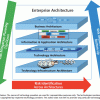Business Transformation Requires Transformational Leaders
Leadership and teaming skills are front and center in times of rapid change. Meet today’s constant disruption head on with expert guidance in leadership, business strategy, transformation, and innovation. Whether the disruption du jour is a digitally-driven upending of traditional business models, the pandemic-driven end to business as usual, or the change-driven challenge of staffing that meets your transformation plans—you’ll be prepared with cutting edge techniques and expert knowledge that enable strategic leadership.
Recently Published
Big Data: Part II -- Legal Issues
An Integrated EA Approach for Effective ERM
Operational risks are the most challenging for any organization, but most can be controlled, if not avoided, as long as the organization builds and implements effective enterprise risk management (ERM) strategies. While there are certainly mature methodologies available for risk identification and assessment, today's organizations fail to build and implement them effectively due to limited practice of these methodologies.
Amazon Joins the DWaaS Craze
Various vendors, including Greenplum (EMC), Kognitio, ParAccel, Teradata, and Vertica Systems (HP), have offered versions of their high-performance analytic databases tailored for use in cloud environments such as Amazon Web Services (AWS) and Elastic Compute Cloud (EC2) platforms for several years now.
Does Agile Help in Innovation?
In today's rapidly changing business environment, innovation is key for survival. Companies may become obsolete in no time in the absence of new and innovative products. A classic example of this phenomenon is the demise of Kodak. At the same time, companies like Apple and Google have not only contributed toward building innovative products but at the same time made their investors many times richer.
Marketecture: Selling Your Cause
Good architects also need to be good "marketects": they must be able to sell and promote their cause as well as publicize their achievements, outcomes, and results. But how do they do this? What tips and guidelines from the world of marketing can architects adopt to their advantage?
Does Agile Help in Innovation?
In today's rapidly changing business environment, innovation is key for survival. Companies may become obsolete in no time in the absence of new and innovative products. A classic example of this phenomenon is the demise of Kodak. At the same time, companies like Apple and Google have not only contributed toward building innovative products but at the same time made their investors many times richer.












